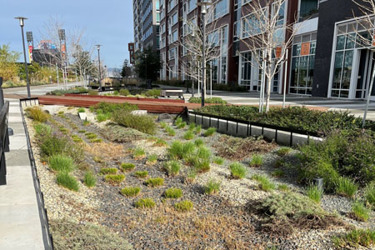Rain Gardens Guarding San Francisco

By Jim Lauria

Laurie Lauria and I spent last week moving out of San Francisco up to Napa, California, dodging the raindrops and taking advantage of a few dry days in this remarkably stormy winter — weather that makes this a perfect time to talk about the need to capture rainwater and protect overwhelmed urban sewer systems.
I've had some issues with San Francisco during the past eight years I've lived in the city. But I have to compliment the San Francisco Public Utilities Commission's rain garden program, a model for urban areas around the world. The commission manages a system with more than 1,000 miles of sewers, thousands of acres of pavement, hills and valleys, and rising sea level that impedes drainage. Making things worse, we've got atmospheric rivers — the massive storm systems that the National Oceanic and Atmospheric Administration (NOAA) says can carry 15 times more water than the Mississippi River — washing over California this winter. And we've got buried rivers, like Mission Creek, which generations ago was shunted into a pipe under downtown and cut off from its ecological role as a release valve for stormwater.
Call it a perfect storm for stormwater disaster.
All the more reason to applaud the PUC's creativity in installing more than 150 sunken gardens to capture stormwater and let it leach into the ground rather than overwhelm the sewer system — and do it in a way that beautifies neighborhoods and engages local residents.
Some of those rain gardens, or "bio-retention planters," are modest boxes cut into curbs on the street, planted with hardy vegetation that can handle dry spells and inundation. Others, like 1.2 acres of Mission Creek bioswales I photographed on January 12 during my daily walk, are downright beautiful. In the San Francisco Chronicle, urban design critic John King said the Mission Creek project looked "like some stylized remnant of the tidal marshes that existed here before...waves of reckless and propulsive growth."
The rain gardens also engage the public. "Rain guardians" recruited by the PUC help keep them free of trash and functioning. What a great way to connect residents to the water issues in their neighborhoods.
When It Rains, It Pours
We're certainly paying the price for that propulsive growth as San Francisco — and California in general — are subjected to massive swings between too much water and too little. On New Year's Eve, San Francisco received 5.5 inches of rain, which is equivalent to the average rainfall for the entire month of December. Between the start of the water year on October 1, 2022 and January 17, 2023, the rain gauge at San Francisco International Airport had already collected more than a full year's worth of precipitation. Still, looking at the big picture, the state is still facing continued drought due to depleted reservoirs and aquifers.
It's not like we haven't been warned. Climatologists have been predicting that the world will experience flashier rain events. Storms will be wetter and dry periods will be drier. Looks like they're right.
After all this rain, it's almost hard to remember that we had a couple of droughty winters after San Francisco PUD installed its rain gardens. But 2023 has already proven that they are needed. Let's make our New Year's Resolution a promise to pursue more of these sorts of projects across San Francisco...and in communities around the world.
